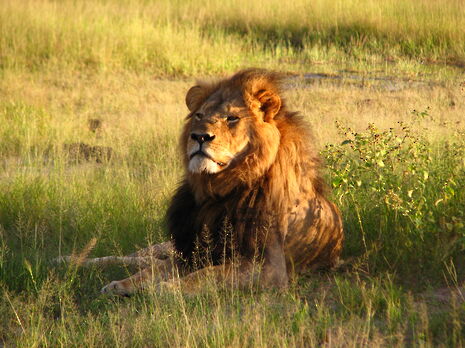Trophy hunting: a necessary evil?
The killing of Cecil the lion sparked a huge controversy, but scientists and conservationists are not so sure about condemning trophy hunting altogether

The world reacted passionately when a Zimbabwean lion named Cecil was killed in July. There were worldwide calls for a ban on trophy hunting as an inhumane and barbaric practice which has no place in a world troubled by species extinction. The news inspired massive efforts to minimise the adverse effects of human activity on habitats and the living world.
But calls to ban all trophy hunting, the killing of wild animals to keep as souvenirs rather than for their meat, may actually undermine conservation efforts.
The evidence suggests that the way Cecil was killed was not only illegal but inhumane. American dentist Walter Palmer is accused of luring the animal away from a wildlife sanctuary before shooting and wounding him with an arrow. The lion then suffered for two days before finally being shot and killed with a rifle, and then skinned and beheaded.
However, conservation experts Niki Rust and Diogo Verissimo claim in a recent publication in The Conversation that Cecil's death should not be a cause for condemnation of all trophy hunting.
"All signs point toward the illegality of the killing of Cecil the Lion, and I can only hope those involved are brought to justice and there are consequences," Verissimo, a conservation biologist at Georgia State University, points out. "But I don't think that single incident in itself is enough to dismiss the entire industry around trophy hunting."
One of the reasons why trophy hunting may actually be beneficial to conservation is that money from it can help to fund conservation efforts where other sources such as government funding or charity contributions might be limited. Trophy hunters typically pay tens or hundreds of thousands of pounds for the right to hunt these animals, and some of that money is collected by wildlife reserves and environmental protection agencies, which can then reinvest it into conservation efforts, Verissimo said.
He also pointed out that the other main source of conservation funding, ecotourism, unfortunately struggles to raise enough money to compete with trophy hunting. The dentist who killed Cecil reportedly paid $50,000 to a professional hunter for the privilege. Last year, another American hunter sparked a similar controversy when he paid $350,000 to kill an endangered black rhino.
It has also been revealed that wildlife research undertaken by the University of Oxford was partially funded by companies which support ‘sustainable trophy hunting’. Professor David MacDonald from the university defended Oxford by stating that research results were not influenced in any way by donor organisations and that there was no conflict of interest. His claim, in fact, aligned with Verissimo's thoughts on how the “small” injustice of trophy hunting is justified by the substantial benefits it can help to bring about.
Another strong argument in favour of trophy hunting's potential benefits is that profitable, legal hunting makes people more likely to protect animals. A study conducted by a team of geographers and biologists, led by Dr Nigel Leader-Williams, Director of Conservation Leadership in the University of Cambridge's Department of Geography, offers strong conclusions in favour of this argument.
Leader-Williams and his team looked at white rhinoceros populations in South Africa before and after the country legalised hunting them. They found that the white rhino population grew from under 100 to over 10,000 since the ban was dropped. Leader-Willaims claims that hunting had made it profitable for landowners to introduce and protect white rhinos on their land; the market incentivised people to actively participate in conservation.
Leader-Williams also found something similar in Zimbabwe: "Implementing trophy hunting has doubled the area of the country under wildlife management relative to the 13 [per cent] in state protected areas," he wrote in a 2011 letter to Science magazine.
In theory then, permitting big-game hunting could also help protect lion populations. However, we should not rush to hasty conclusions. A potential answer to the conundrum might lie in a balance between the two extremes: while trophy hunting should be severely limited to only a few occasions per year on ethical grounds, the benefits which arise from it should not be denied altogether. Further studies should be conducted into other species in other habitats to either confirm or refute the conclusion of Leader-Williams's research.
Studies show that trophy hunting may have its benefits for conservation efforts, at least in certain species such as the white rhinoceros, which can be extrapolated to other wild animals. Cecil's unfortunate death, much debated and decried, will hopefully inspire more research and wider debate about conservation, and thus will not have been in vain.
 Comment / Anti-trans societies won’t make women safer14 November 2025
Comment / Anti-trans societies won’t make women safer14 November 2025 Fashion / You smell really boring 13 November 2025
Fashion / You smell really boring 13 November 2025 News / Controversial women’s society receives over £13,000 in donations14 November 2025
News / Controversial women’s society receives over £13,000 in donations14 November 2025 Features / Beyond the Pitt Club: The Cambridge secret societies you have never heard of16 November 2025
Features / Beyond the Pitt Club: The Cambridge secret societies you have never heard of16 November 2025 News / Pembroke flood damage forces ‘costly’ repairs17 November 2025
News / Pembroke flood damage forces ‘costly’ repairs17 November 2025









